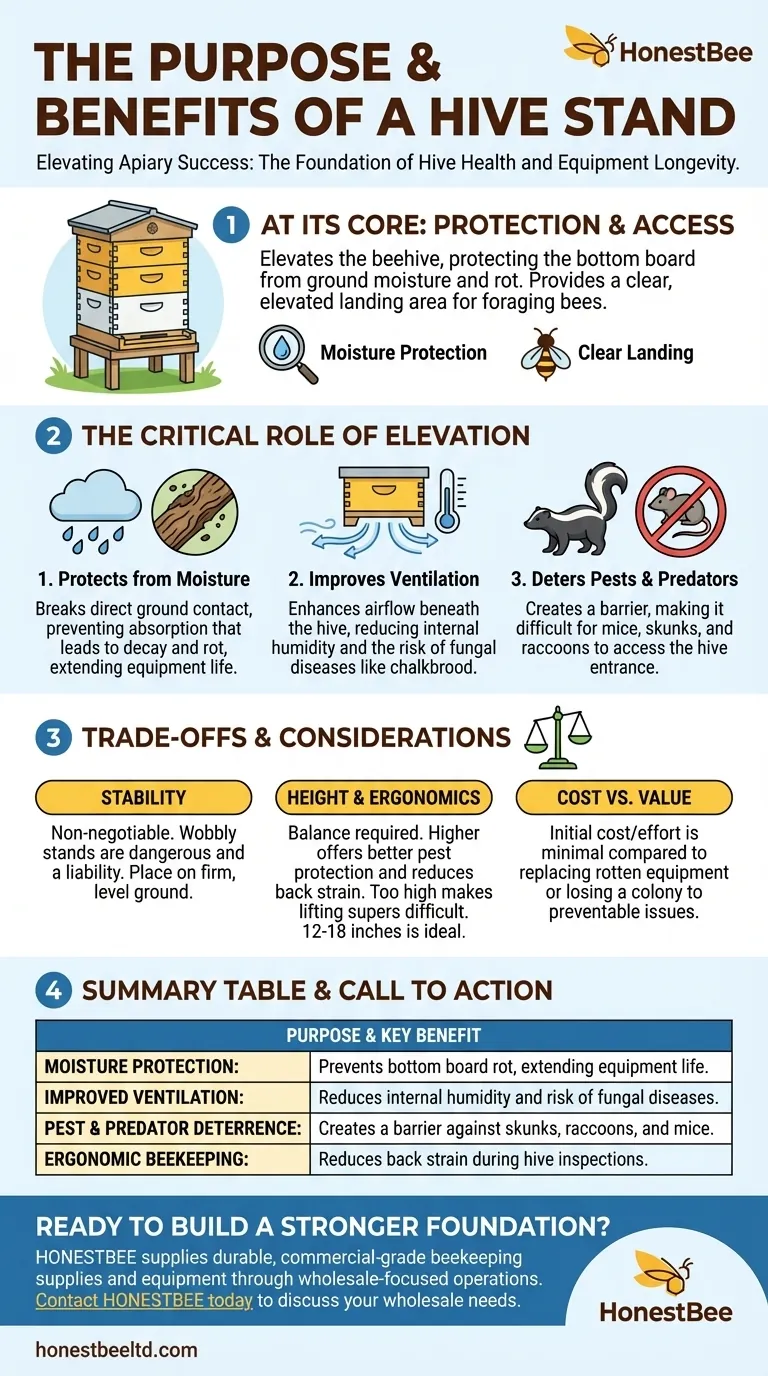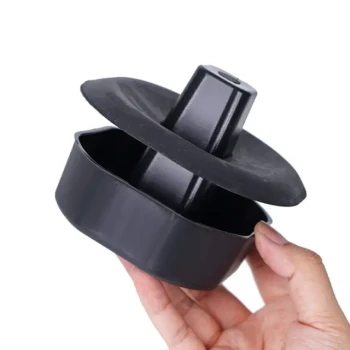At its core, a hive stand is a dedicated structure that elevates a beehive off the ground. Its primary purposes are to protect the hive's wooden components, particularly the bottom board, from ground moisture and rot, and to provide a clear, elevated landing area for foraging bees returning to the colony.
While often viewed as a simple accessory, a hive stand is a foundational investment in proactive hive management. It is your first line of defense against ground-based threats like moisture and pests, directly impacting both the longevity of your equipment and the health of your colony.

The Critical Role of Elevation
A hive stand does more than just lift a box; it creates a controlled micro-environment that solves several fundamental beekeeping challenges. Understanding these functions reveals why it is considered essential by most experienced apiarists.
Protecting Your Equipment from Moisture
A Langstroth hive's bottom board is constantly exposed to the elements. When placed directly on the ground, it absorbs moisture, leading to fungus, decay, and rot.
Elevating the hive by just a few inches breaks this direct contact. This simple separation dramatically extends the life of your woodenware, saving you the cost and labor of frequent replacements.
Improving Colony Health Through Ventilation
Keeping the hive off the ground improves airflow beneath the bottom board. This helps prevent the base from becoming a damp, cool surface that can chill the brood nest above it.
Proper ventilation is critical for helping the colony manage internal humidity, reducing the risk of fungal diseases like chalkbrood and ensuring a healthier environment for the bees.
Deterring Pests and Predators
Elevation creates a significant barrier for ground-dwelling pests. A hive on the ground is an easy target for mice seeking a warm winter shelter or skunks and raccoons attempting to raid the entrance.
Lifting the hive 12 to 18 inches makes it considerably more difficult for these predators to access and disturb the colony, contributing to the hive's overall security and reducing stress on the bees.
Understanding the Trade-offs and Considerations
While highly beneficial, implementing a hive stand requires careful thought. Simply using one is not enough; it must be the right one for your situation and be installed correctly.
Stability is Non-Negotiable
The most critical factor is stability. A wobbly or uneven hive stand is a major liability and far more dangerous than no stand at all.
A full hive can weigh hundreds of pounds. A collapse could not only destroy the colony and your equipment but also create a significant safety hazard. Always ensure your stand is placed on firm, level ground.
Height and Ergonomics
The ideal height is a balance. A higher stand offers better pest protection and reduces the back strain required for hive inspections, as you don't have to bend over as far.
However, a stand that is too high can make it difficult and dangerous to lift heavy honey supers onto the top of the hive stack. Most beekeepers find a height of 12 to 18 inches to be a practical compromise.
The Cost vs. Value Calculation
You can purchase commercial hive stands or build your own from simple materials like wood or cinder blocks. While there is an initial cost or effort involved, this should be weighed against the long-term value.
The cost of a sturdy stand is minimal compared to the cost of replacing a rotted-out bottom board or, worse, losing an entire colony to preventable moisture issues or predation.
Making the Right Choice for Your Apiary
The best hive stand solution depends entirely on your specific goals and environment.
- If your primary focus is budget and simplicity: Use two or three sturdy cinder blocks to create a level, elevated base that keeps the hive off the ground.
- If your primary focus is pest control: Choose a stand that elevates the hive at least 18 inches and consider placing the legs in cans of oil to deter crawling insects.
- If your primary focus is beekeeper comfort: Build or buy a stand that raises the bottom board to a height that minimizes your need to bend during inspections.
Ultimately, providing a stable and elevated foundation is one of the most effective first steps you can take to ensure a healthy, productive, and long-lasting colony.
Summary Table:
| Purpose | Key Benefit |
|---|---|
| Moisture Protection | Prevents bottom board rot, extending equipment life. |
| Improved Ventilation | Reduces internal humidity and risk of fungal diseases. |
| Pest & Predator Deterrence | Creates a barrier against skunks, raccoons, and mice. |
| Ergonomic Beekeeping | Reduces back strain during hive inspections. |
Ready to build a stronger foundation for your apiary?
For commercial apiaries and beekeeping equipment distributors, the right equipment is the bedrock of success. A high-quality hive stand is a simple, cost-effective investment that pays dividends in hive health and equipment longevity.
HONESTBEE supplies durable, commercial-grade beekeeping supplies and equipment through wholesale-focused operations. We help you protect your investment and support thriving colonies.
Contact HONESTBEE today to discuss your wholesale needs and discover how our equipment can contribute to the success and scalability of your beekeeping operation.
Visual Guide

Related Products
- Plastic Bee Hive Stand for Beekeeping
- Metal Bee Hive Stand Bee Box Stand for Beekeeping
- Metal Hive Feet Bee Hive Stand for Ant Protection
- Professional Drop-Style Hive Handles for Beekeeping
- Professional Ant-Proof Beehive Stand with Integrated Moat for Beekeeping
People Also Ask
- How does the longevity of plastic bee hives compare to wooden hives? Discover the Durable Choice
- What are the advantages of a second hive if the queen is killed? The Ultimate Insurance Policy for Your Apiary
- Why is elevating the hive important? A Simple Step for a Healthier, More Productive Colony
- Why is it important to level a hive stand properly? Prevent Catastrophic Failure & Ensure Hive Health
- How do bees regulate the temperature of their hive during the summer? Discover Their Natural Cooling System



















